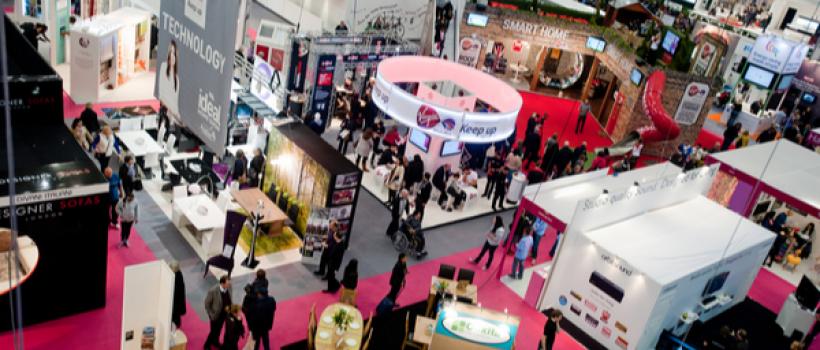
International trade show preparation can seem like a daunting task. Unlike domestic trade shows, preparing for an international trade show requires extra time and planning to account for the travel, extra expenses, logistical arrangements, and language barriers involved.
Why go through the stress of an international trade show? International trade shows provide a great way for small businesses to both explore new markets and expand relationships in countries where they’re already selling. According to Evo Exhibits, there are five primary benefits to exhibiting at a trade show—whether international or domestic:
-
Raising brand awareness among consumers and industry experts
-
Forging new business relationships
-
Finding highly targeted leads for your sales team
-
Learning more about your competition
-
Discovering the newest developments and technologies in your industry
The myriad benefits of attending and exhibiting at an international trade show don’t come without a cost, though. Exhibiting even at domestic shows requires things like booth space and marketing collateral, which can cost a company thousands of dollars. When you add in the extra costs of travel and shipping, the costs of international trade show preparation can soar even higher.

That’s why international trade show preparation is so important. With the proper planning, you can keep costs down and get the most value out of efforts abroad. International events of this nature can change the way you approach every aspect of a trade show opportunity: marketing tactics, face-to-face interactions, transport of your product and collateral to the show, and even the business cards you hand out.
With that in mind, here are 7 ways to help make your international trade show preparation a huge success.
International Trade Show Preparation Tips
-
Know the Goals of Your Trade Show Exhibition
Before you decide to exhibit at an international trade show, determine the primary goal of your attendance. Your main objective will depend on whether or not you have an established sales presence in the country already.
If you don’t have an established sales presence in the country, an international trade show exhibit can be a great way to interact personally with future customers and your local competition. There are plenty of resources to help you discover trade shows for your industry; if you’ve done your research into foreign markets, then choose the country you want to start selling in and find the right show.
If you already have an established sales presence in the country, odds are you’re exhibiting for one of two reasons: sales meetings or product exposure. Face-to-face meetings at trade shows are nearly 50% cheaper than meeting at a prospect’s office. This cost savings is especially true with international trade shows, where you can hold multiple meetings in the same place during a single trip instead of requiring multiple costly visits. If your goal is to get more exposure for your products, you’re in luck—that just so happens to be the number one reason people attend trade shows.
-
Do Your Research
If you’re new to the country or region where the trade show is being held, it’s critical to do your research on the area before you get in too deep. Business culture and practices vary widely from country to country in places like Latin America, and you’ll need to know these differences when you plan your exhibit.
Trade show season starts heating up in January across Latin America, for example. With the exception of the months of August and December, it continues steadily throughout the year. Major shows—each hosting thousands of attendees—include:
-
Colombiatex of the Americas in Colombia for clothing, shoes, leather goods, fabrics, and equipment
-
Expo ANTAD & Alimentaria in Mexico for merchandise including food and beverages, personal care products and furniture
-
FEICON BATIMAT in Brazil for hardware, lighting, kitchen and bath, and construction equipment
-
Arminera in Argentina, an international trade fair for vendors, suppliers, and decision-makers in the mining and energy sectors
If you’re attending a trade show where you can sell on the spot, you may need to do more than have a credit card machine on hand. 49% of people in Latin America and the Caribbean are unbanked, and cash vouchers make it possible for them to pay digitally. There are many other accepted forms of payment, including bank transfers and installments, and the popularity of payment methods differs country to country.
Language is another important consideration. While English is the language of international business, if you’re attending a more regional trade show, it may not be the dominant language. Reach out to the company producing the trade show to understand the demographics and language expectations. If possible, take someone with you who speaks the language and is familiar with the local culture.
When it comes to international trade show preparation, you can never ask too many questions.
-
Consider the Timing
Finding enough time to prepare a domestic trade show exhibit can be tough, but international trade shows add another layer of difficulty. To properly prepare, you’ll need about a year.
For international trade shows, consider the time it takes to get passports and visas for your staff. You’ll also need to build in time to coordinate logistics in a foreign country—and, potentially, in a foreign language.
Shipping time for items in the exhibit is one thing many people don’t consider until it’s too late. All of the supplies you need to make your exhibit pop need to pass through customs, which can add a few days—or weeks—to the shipment time, depending on the country.

-
To Ship or Not to Ship?
The design (and cost) of your booth hinges upon whether you want to ship—thus, buy—or rent your booth. Renting is a good option for your international trade show preparation if you’ll be attending multiple trade shows in one trip or you change your branding often.
If you choose to buy and ship your booth, you need to build in enough time to assemble it upon arrival. Work with a logistics provider who specializes in shipping to the country in which the trade show is located. If you’re shipping your booth to Colombia, for example, a company like SkyPostal has a trusted end-to-end network of couriers to ensure that your booth arrives on time.
-
Design for Your Audience
You’ve decided who your target audience is and how you’re going to get your booth there—now you can begin designing it. The booth needs to accomplish a lot of things at once: support your goals for the trade show, promote your brand, and differentiate you from the competition.
International trade shows add another layer of design complexity because you may need to create a booth that has a display in multiple languages.
If you’re planning to ship your booth, make sure you create a design that can survive the long trip—and bring backup components for fragile items, like lighting.

-
Train the Sales Team
The team you send to either a domestic or international trade show needs to be well trained. As the representatives of the company at the show, the sales team must know how to dress, how to interact, and what to say about the products.
International trade show preparation also requires addressing challenges like language barriers and cultural differences. In Colombia, for example, being late to a meeting is not seen as offensive and is rather common in business. So if you’re scheduling meetings during the show, your sales team will need to be prepared for lateness and expect meetings to run long.
-
Work Local Contacts
International trade shows are a great chance to connect to local retailers, suppliers, and logistics providers as you build business overseas. Take time away from the trade show floor to meet face-to-face with your current local contacts or prospective local contacts.
Let SkyPostal Help You Expand Your Business
Successful international trade show preparation requires solid logistics knowledge and expertise about the country where your trade show is taking place. As you grow your business in the Latin America, you need a partner that knows the particularities of shipping to the region.
Get in touch today to learn how we can help support your business’s new shipping needs in Latin America.

